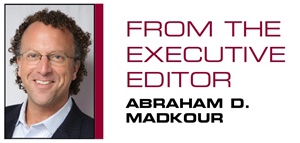I took in my first visit to Daytona International Speedway for a quick trip prior to the 500, as we held the second part of our Motorsports Marketing Forum that included tours of the $400 million renovation project, Daytona Rising. Having never visited the famed speedway, comparisons were impossible. But I came away impressed.
We have closely monitored the plans of International Speedway Corp., its CEO Lesa France Kennedy and track President Joie Chitwood, dating to September 2012 when Chitwood outlined a vision for the facility, telling us, “We have to think about this property moving forward and create a great fan experience and an experience that sponsors and brands want to be a part of.” He talked about dramatically improving the corporate hospitality experience at the track. A few months later, he outlined the corporate thesis of remaking a speedway into something far bigger, saying the renovation “takes on that professional stadium feel.”
That was the first time I recall hearing “stadium” applied to a renovated DIS, and after touring the facility on a Wednesday afternoon during practice, I feel they succeeded in offering a modern-day stadium feel. I spoke to many of the 100-plus people who toured the complex that afternoon, a number of whom were veterans of the Daytona experience, and plenty of cynics. There was unanimous praise of a drastically improved experience, far from the tight confines and maze-like footprint of before. From my viewpoint, the open concourses, enhanced “front porches” overlooking the track, common areas for fans to mingle, stand and watch, and unbelievably well-situated and economical loge boxes along the finish, stood out.
The four sponsored entrances were big, bold and immersive, and stood out for different reasons. Toyota specifically went big with three vehicles hanging from the risers on the fourth level, with room for one more. Escalators neatly tucked to the side of the venue ease the challenges of previously strenuous vertical climbs; large wayfinding signage is clean and expedites traffic flow; hospitality neighborhoods line the new premium level; and the Rolex 24 at Daytona Lounge is as posh as any high-end stadium club. I went back and reread the plans set forth by track officials in the planning and believe that they have delivered on what they promised: a dramatically improved fan experience with far more engaging and compelling ways for brands to integrate into the fabric of the facility.
Critics will find areas to nitpick and surely there are areas for improvements, but the early returns are positive. Media praised the renovation, and fan reaction was overwhelmingly positive from sources who stayed the weekend. And one can’t forget all this was done while ISC deflected the narrative that it decreased previous capacity by a whopping 60,000 seats in this whole process — the size of many facilities currently on the drawing board — and a gut-check on the ticket challenges that come with motorsports these days.
ISC now shifts its focus to getting a menu of other events to make DIS a year-round destination and to the $120 million to $150 million first phase of the 181-acre development across the street, One Daytona, which got a dose of good news with new tenants and two Marriott hotels signed on for the project. The Daytona Rising model can be exported to other tracks, and while no other ISC facility will take on a renovation of such scale, you could see projects a quarter to a third the size.
Perspective is needed — this isn’t a new $2 billion-plus stadium; it’s a $400 million renovation of a building that was opened in 1959. But there is a bigger picture: Motorsports has remained on the sidelines of the trends in building enhancements and improving the in-venue experience for today’s fans, but in one dramatic move, it now has a model to build on.
Abraham D. Madkour can be reached at amadkour@sportsbusinessjournal.com.




